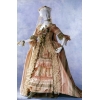|
 XVIII century
is the regal annals of royal dynasty ends and tragedy of revolutions. In the world
of fashion this time is also revolutionary. The decline of royal families and the
new epoch of the developing capitalism brought to the rejection of traditions
in costumes that transformed to the slightest extent throughout the century and
appearance of new tendencies, drastically new for the time. Historians called the
century as the «courteous» epoch in France that efficiently influenced
the world of fashion. The new careless time occurred in there followed the reign
of Louis XIV with light graceful dresses and costumes. XVIII century
is the regal annals of royal dynasty ends and tragedy of revolutions. In the world
of fashion this time is also revolutionary. The decline of royal families and the
new epoch of the developing capitalism brought to the rejection of traditions
in costumes that transformed to the slightest extent throughout the century and
appearance of new tendencies, drastically new for the time. Historians called the
century as the «courteous» epoch in France that efficiently influenced
the world of fashion. The new careless time occurred in there followed the reign
of Louis XIV with light graceful dresses and costumes.
All the attires
and images were accompanied with the high powdered wigs, white-snow skin that
looks pale with the same powder and tiny beauty spots accentuating the
paleness. The fluffy skirts supported by framework from the willow twigs or
whalebone, so called pannier, and were extremely popular among the fashionistas
of the epoch. During the reign of Marie-Antoinette ladies from high society
would wear pannier with elbows, when the skirt enlarged from both sides due to
the special framework acquiring the distinctive symmetric elation. The girdle bodice
was used to push the bosom up making it alluring.
Marie-Antoinette,
the Queen of France, committed to the world of fashion who was the real
trendsetter of the time. In particular, it was Marie-Antoinette who entered the
history of France
as the passionate devotee of puffy attires. She introduced the fashion for the high
hairdos, which sometimes achieved a height of over a meter decorated with
various details like feathers, flowers, bands, jewelry. The hairdo was almost
the major accessory in the ensemble of a woman of that time than any other
accessory. Besides, she introduced bustles presented as the special pad at the
lower waistline on the back cloth of the lower part of the skirt. These pads drew
the typical silhouette with the especially prominent back.
The pretentious
puffiness and lavishness of attire that royal families and the court adopted in
France,
could not help causing the loudly growing dissatisfaction of ordinary
population. The economy of the country was found in very ill condition and
partly because of extravagant expenditures Marie-Antoinette afforded herself. France was Франция swiftly becoming a beggar and
the oppressive tension was growing in the society which led to the revolution,
eventually.
For three years
the absolute monarchy in France
that reigned in the country throughout centuries was broken, new foundations
were established in the society and the extremely new fashion tendencies
originated.
Bourgeois society
roused in France and
neighboring Great Britain
required a new fashion trend and in response to the unreasonable luxury by the
noble people new styles and silhouettes was created based on comfort and
durability. The society is obliged to Great Britain, on the whole, for democratization
of the fashion when the new class, bourgeoisie, conditioned the occurrence of
clothes which was not the unique symbol of the social status. Unlike the lavish
attires of people from the high society, the new clothes was made from
affordable fabric like satin, silk and practical wool, and new shapes, laconic
and simple, replaced the fluffy skirts.
The latest decades
of the XVIII century was known for the new trend in cultural life of the country
when the epoch of neoclassicism appeared there, being the style that influenced
the fashion, painting, architecture and sculpture. Thanks to the neoclassicism the
antique style was introduced to public and classic canons set by the antique
epoch returned to catwalks.
Fluffy
pannier skirts with girdles disappeared from wardrobe of women, replaced by austere
and laconic garments made of single-color fabric.
The distinctive
feature of women’s dress of the late XVIII century is the strict and simple
silhouette and the closely-tight skirt with the high waistline than conflicted
with the fluffy girdle skirts which were in two decades ago. Gradually women
refused from wearing stiletto shoes to favor for practical flats.
|